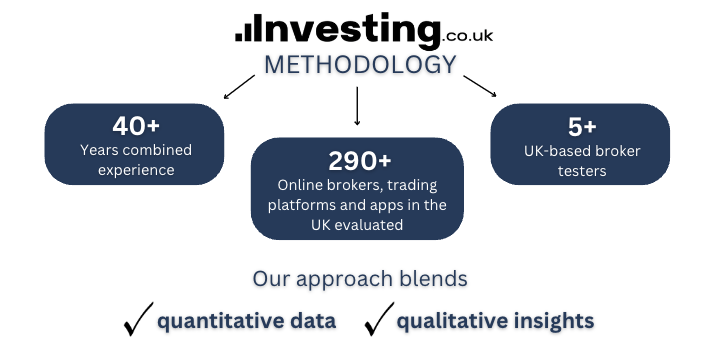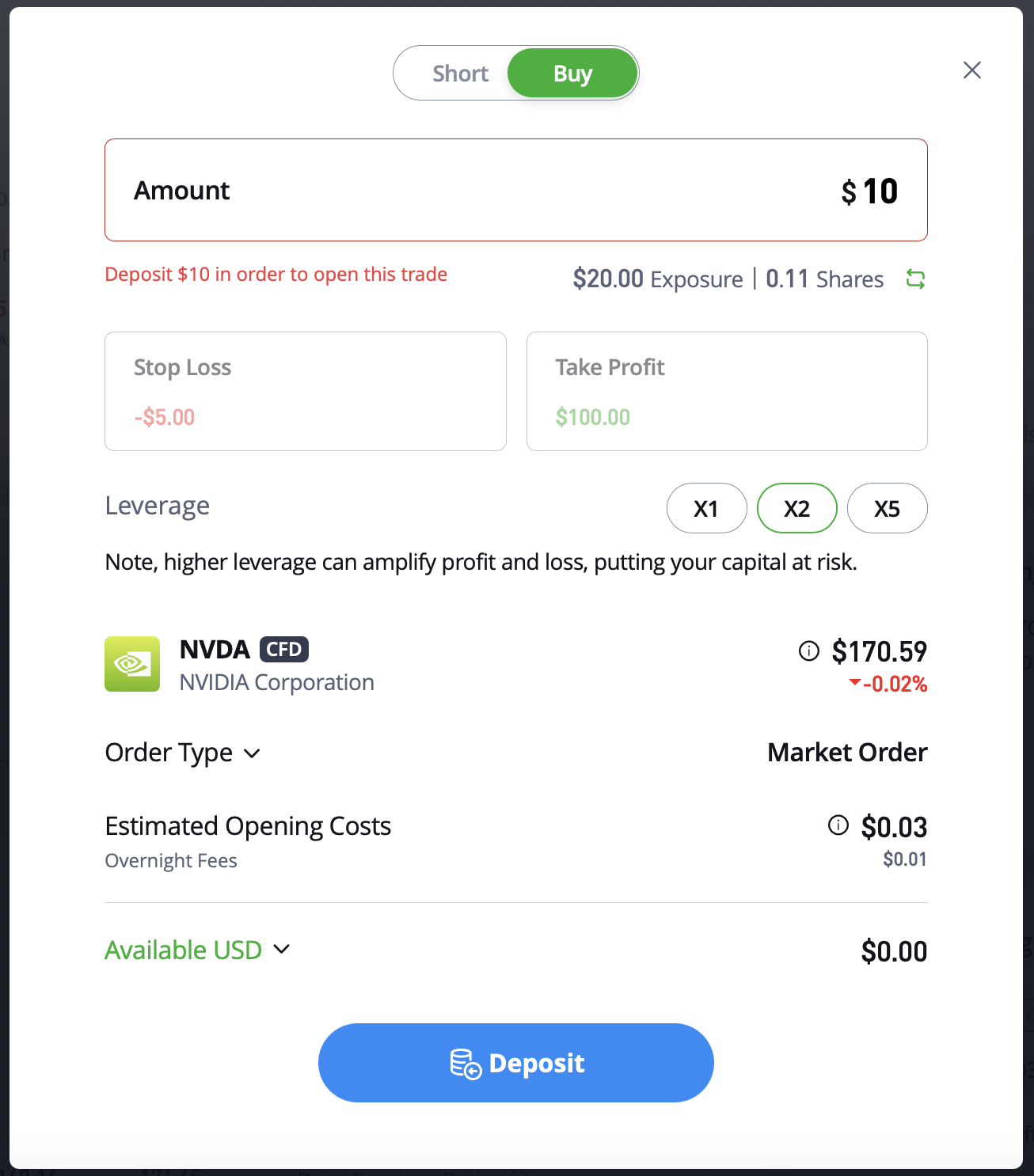Best Brokers With Low Leverage 2025
Brokers with low leverage rates offer investors the opportunity to magnify the scale of their profits without exposing themselves to excessive risk. This supports sensible risk management and is well suited to beginner traders.
Dig into our list of the best UK brokers for low leverage, with insights into the size of margin trading opportunities and account safeguards.
Top Brokers For Low Leverage Trading
-
Founded in Australia in 2010, Pepperstone is a highly regarded broker specialising in forex and CFDs. Serving more than 400,000 clients globally, it provides access to over 1,300 financial instruments through popular platforms like MT4, MT5, cTrader, and TradingView. Its fee structure is both low and transparent. With regulation by reputable bodies such as the FCA, ASIC, and CySEC, Pepperstone guarantees a safe trading environment for traders at every level.
Instruments Regulator Platforms CFDs, Forex, Currency Indices, Stocks, Indices, Commodities, ETFs, Crypto (only Pro clients), Spread Betting FCA, ASIC, CySEC, DFSA, CMA, BaFin, SCB MT4, MT5, cTrader, TradingView, AutoChartist, DupliTrade, Quantower Min. Deposit Min. Trade Leverage $0 0.01 Lots 1:30 (Retail), 1:500 (Pro) -
Established in Poland in 2002, XTB caters to over a million clients worldwide. This forex and CFD broker offers a robust regulatory framework, a diverse range of assets, and prioritises trader satisfaction. It provides an intuitive proprietary platform equipped with excellent tools to support aspiring traders.
Instruments Regulator Platforms CFDs on shares, Indices, ETFs, Raw Materials, Forex currencies, cryptocurrencies, Real shares, Real ETFs FCA, CySEC, KNF, DFSA, FSC xStation Min. Deposit Min. Trade Leverage $0 0.01 Lots 1:30 -
FXCC, a well-established brokerage since 2010, offers cost-effective online trading. Registered in Nevis and regulated by CySEC, it is distinguished by its ECN conditions and absence of a minimum deposit requirement. The account opening process is efficient, taking under five minutes.
Instruments Regulator Platforms CFDs, Forex, Indices, Commodities, Crypto CySEC MT4, MT5 Min. Deposit Min. Trade Leverage $0 0.01 Lots 1:500 -
IC Markets is an internationally acclaimed forex and CFD broker, admired for its competitive pricing, diverse trading instruments, and superior technology. Established in 2007 and based in Australia, the firm is under the regulation of ASIC, CySEC, and FSA. It has successfully drawn over 180,000 clients from more than 200 nations.
Instruments Regulator Platforms CFDs, Forex, Stocks, Indices, Commodities, Bonds, Futures, Crypto ASIC, CySEC, CMA, FSA MT4, MT5, cTrader, TradingView, TradingCentral, DupliTrade, Quantower Min. Deposit Min. Trade Leverage $200 0.01 Lots 1:30 (ASIC & CySEC), 1:500 (FSA), 1:1000 (Global) -
Interactive Brokers (IBKR), a leading brokerage, offers access to 150 markets across 33 countries and provides extensive investment services. With more than 40 years of experience, this Nasdaq-listed company complies with strict regulations from the SEC, FCA, CIRO, and SFC. It is among the most reliable brokers worldwide for traders.
Instruments Regulator Platforms Stocks, Options, Futures, Forex, Funds, Bonds, ETFs, Mutual Funds, CFDs, Cryptocurrencies FCA, SEC, FINRA, CFTC, CBI, CIRO, SFC, MAS, MNB, FINMA, AFM Trader Workstation (TWS), IBKR Desktop, GlobalTrader, Mobile, Client Portal, AlgoTrader, OmniTrader, TradingView, eSignal, TradingCentral, ProRealTime, Quantower Min. Deposit Min. Trade Leverage $0 $100 1:50 -
IC Trading belongs to the reputable IC Markets group. Designed for dedicated traders, it offers highly competitive spreads, dependable order execution, and sophisticated trading tools. However, it operates from Mauritius, an offshore financial centre, allowing high leverage but within a less regulated environment.
Instruments Regulator Platforms CFDs, Forex, Stocks, Indices, Commodities, Bonds, Cryptos, Futures FSC MT4, MT5, cTrader, AutoChartist, TradingCentral Min. Deposit Min. Trade Leverage $200 0.01 Lots 1:500 -
Trade Nation is a leading FX and CFD broker regulated in the UK and Australia, among other places. The company provides competitively priced fixed and variable spreads on over 1,000 assets. Traders benefit from advanced platforms and comprehensive training materials. Additionally, the Signal Centre offers valuable trade ideas.
Instruments Regulator Platforms Forex, CFDs, Indices, Shares, Commodities, Futures, Bonds, Spread Betting, Cryptos (Bahamas Entity Only) FCA, ASIC, FSCA, SCB, FSA MT4 Min. Deposit Min. Trade Leverage $0 0.1 Lots 1:500 (entity dependent)
Safety Comparison
Compare how safe the Best Brokers With Low Leverage 2025 are and what features they offer to protect traders.
| Broker | Trust Rating | FCA Regulated | Negative Balance Protection | Guaranteed Stop Loss | Segregated Accounts |
|---|---|---|---|---|---|
| Pepperstone | ✔ | ✔ | ✘ | ✔ | |
| XTB | ✔ | ✔ | ✔ | ✔ | |
| FXCC | ✘ | ✔ | ✘ | ✔ | |
| IC Markets | ✘ | ✔ | ✘ | ✔ | |
| Interactive Brokers | ✔ | ✔ | ✘ | ✔ | |
| IC Trading | ✘ | ✘ | ✘ | ✔ | |
| Trade Nation | ✔ | ✔ | ✘ | ✔ |
Payments Comparison
Compare which popular payment methods the Best Brokers With Low Leverage 2025 support and whether they have trading accounts denominated in British Pounds (GBP).
| Broker | GBP Account | Debit Card | Credit Card | Neteller | Skrill | Apple Pay |
|---|---|---|---|---|---|---|
| Pepperstone | ✔ | ✔ | ✔ | ✔ | ✔ | ✔ |
| XTB | ✔ | ✔ | ✔ | ✔ | ✔ | ✘ |
| FXCC | ✔ | ✔ | ✔ | ✔ | ✔ | ✘ |
| IC Markets | ✔ | ✘ | ✔ | ✔ | ✔ | ✘ |
| Interactive Brokers | ✔ | ✔ | ✘ | ✘ | ✘ | ✘ |
| IC Trading | ✔ | ✔ | ✔ | ✔ | ✘ | ✘ |
| Trade Nation | ✔ | ✔ | ✔ | ✘ | ✔ | ✘ |
Mobile Trading Comparison
How good are the Best Brokers With Low Leverage 2025 at mobile trading using apps or other mobile interfaces.
| Broker | Mobile Apps | iOS Rating | Android Rating | Smart Watch App |
|---|---|---|---|---|
| Pepperstone | iOS & Android | ✘ | ||
| XTB | iOS & Android | ✔ | ||
| FXCC | iOS & Android | ✘ | ||
| IC Markets | iOS & Android | ✘ | ||
| Interactive Brokers | iOS & Android | ✔ | ||
| IC Trading | iOS & Android | ✘ | ||
| Trade Nation | iOS & Android | ✘ |
Beginners Comparison
Are the Best Brokers With Low Leverage 2025 good for beginner traders, that might want an affordable setup to get started, along with good support and educational resources?
| Broker | Demo Account | Minimum Deposit | Minimum Trade | Support Rating | Education Rating |
|---|---|---|---|---|---|
| Pepperstone | ✔ | $0 | 0.01 Lots | ||
| XTB | ✔ | $0 | 0.01 Lots | ||
| FXCC | ✔ | $0 | 0.01 Lots | ||
| IC Markets | ✔ | $200 | 0.01 Lots | ||
| Interactive Brokers | ✔ | $0 | $100 | ||
| IC Trading | ✔ | $200 | 0.01 Lots | ||
| Trade Nation | ✔ | $0 | 0.1 Lots |
Advanced Trading Comparison
Do the Best Brokers With Low Leverage 2025 offer features that allow for more advanced trading strategies?
| Broker | Automated Trading | Pro Account | Leverage | VPS | AI | Low Latency | Extended Hours |
|---|---|---|---|---|---|---|---|
| Pepperstone | Expert Advisors (EAs) on MetaTrader | ✔ | 1:30 (Retail), 1:500 (Pro) | ✔ | ✘ | ✔ | ✘ |
| XTB | - | ✔ | 1:30 | ✘ | ✘ | ✔ | ✘ |
| FXCC | Expert Advisors (EAs) on MetaTrader | ✘ | 1:500 | ✔ | ✘ | ✔ | ✘ |
| IC Markets | Expert Advisors (EAs) on MetaTrader, cBots on cTrader, Myfxbook AutoTrade | ✘ | 1:30 (ASIC & CySEC), 1:500 (FSA), 1:1000 (Global) | ✔ | ✘ | ✔ | ✘ |
| Interactive Brokers | Capitalise.ai, TWS API | ✘ | 1:50 | ✘ | ✔ | ✔ | ✔ |
| IC Trading | Expert Advisors (EAs) on MetaTrader, cBots on cTrader | ✘ | 1:500 | ✔ | ✘ | ✔ | ✘ |
| Trade Nation | Expert Advisors (EAs) on MetaTrader | ✘ | 1:500 (entity dependent) | ✘ | ✘ | ✘ | ✘ |
Detailed Rating Comparison
Use this heatmap to compare our detailed ratings for all of the Best Brokers With Low Leverage 2025.
| Broker | Trust | Platforms | Mobile | Assets | Fees | Accounts | Support | Research | Education |
|---|---|---|---|---|---|---|---|---|---|
| Pepperstone | |||||||||
| XTB | |||||||||
| FXCC | |||||||||
| IC Markets | |||||||||
| Interactive Brokers | |||||||||
| IC Trading | |||||||||
| Trade Nation |
Our Take On Pepperstone
"Pepperstone is a premier trading platform, providing tight spreads, swift execution, and sophisticated charting tools for seasoned traders. Beginners benefit from no minimum deposit, comprehensive learning materials, and outstanding 24/7 support."
Pros
- Pepperstone offers rapid execution speeds of approximately 30ms, enabling swift order processing and execution, making it ideal for traders.
- Pepperstone now offers spread betting via TradingView, delivering a streamlined and tax-efficient trading experience with sophisticated analytical tools.
- The award-winning customer support can be accessed through phone, email, or live chat. During tests, response times have consistently been under 5 minutes.
Cons
- Pepperstone's demo accounts expire after 30 days, which may not provide sufficient time to explore various platforms and evaluate trading strategies.
- Although its market range has improved, its crypto offerings remain limited compared to brokers specialising in this sector, lacking real coin investment options.
- Pepperstone doesn't offer cTrader Copy, a favoured feature for copying trades found in the cTrader platform, which is available on other platforms such as IC Markets. However, Pepperstone has launched its own user-friendly copy trading app.
Our Take On XTB
"XTB excels for novice traders with its superb xStation platform, minimal trading costs, no required deposit, and outstanding educational resources, many of which are fully integrated into the platform."
Pros
- XTB processes withdrawals swiftly, paying within 3 business days, subject to the method and amount.
- Setting up an XTB account is straightforward and fully online, requiring only a few minutes. This simplicity eases new traders into the world of trading.
- XTB offers a superb array of educational resources, such as training videos and articles, embedded within the platform to assist traders of all experience levels.
Cons
- XTB lacks a raw spread account, a feature increasingly offered by competitors such as Pepperstone. This omission might not satisfy traders seeking the most competitive spreads.
- The demo account lasts only four weeks, posing a challenge for traders wanting to fully explore the xStation platform and refine short-term strategies before investing actual money.
- XTB has stopped supporting MT4, restricting traders to its own platform, xStation. This decision may discourage experienced traders accustomed to using the MetaTrader suite.
Our Take On FXCC
"FXCC remains a top choice for forex traders, offering over 70 currency pairs, very tight spreads from 0.0 pips in tests, and high leverage up to 1:500 with the ECN XL account."
Pros
- FXCC offers competitive and transparent ECN spreads starting from 0.0 pips, with no commissions. This makes it one of the most cost-effective forex brokers available.
- There are no deposit fees other than standard cryptocurrency mining charges, which benefits active traders.
- FXCC is a trusted and licensed broker under the regulation of CySEC, a leading European authority ensuring excellent safeguarding standards.
Cons
- The range of research tools, such as Trading Central and Autochartist, is quite limited. Leading platforms in this category, like IG, offer more advanced features.
- Unaware traders might face steep withdrawal fees, such as a notable $45 for bank transfers.
- While the MetaTrader suite excels in technical analysis, its outdated design detracts from the overall trading experience, particularly when contrasted with contemporary platforms such as TradingView.
Our Take On IC Markets
"IC Markets provides excellent pricing, swift execution, and easy deposits. With cutting-edge charting tools like TradingView and the Raw Trader Plus account, it continues to be a preferred option for intermediate and advanced traders."
Pros
- IC Markets provides reliable 24/5 support, especially for account and funding queries, drawing from direct experience.
- In 2025, IC Markets earned DayTrading.com's accolade for 'Best MT4/MT5 Broker' due to its top-tier MetaTrader integration. This achievement highlights the broker's continuous refinement over the years to enhance the platform experience.
- IC Markets provides some of the industry's narrowest spreads, offering 0.0-pip spreads on major currency pairs. This makes it an extremely cost-effective choice for traders.
Cons
- IC Markets provides metals and cryptocurrencies for trading through CFDs, though the selection is narrower compared to brokers such as eToro. This limits opportunities for traders focused on these asset classes.
- Certain withdrawal methods incur fees, including a $20 charge for wire transfers. These costs can reduce profits, particularly with frequent withdrawals.
- Although there are four top-tier third-party platforms available, the absence of in-house software or a trading app tailored for novice traders is notable.
Our Take On Interactive Brokers
"Interactive Brokers ranks highly for seasoned traders due to its robust charting platforms, live data, and bespoke layouts via the new IBKR Desktop app. Its competitive pricing and sophisticated order choices appeal to traders, and its wide equity options are industry-leading."
Pros
- The TWS platform is tailored for intermediate and advanced traders, featuring over 100 order types and a dependable real-time market data feed with exceptional uptime.
- The new IBKR Desktop platform combines the top features of TWS with customised tools such as Option Lattice and MultiSort Screeners, providing an impressive trading experience for traders of all skill levels.
- IBKR offers an economical environment for traders, featuring low commissions, narrow spreads, and a clear fee structure.
Cons
- Support can be sluggish and frustrating. Tests reveal that you may face challenges reaching customer service quickly, which could result in delays in issue resolution.
- The learning curve for TWS is quite steep, making it tough for novice traders to navigate and grasp all its features. In contrast, Plus500's web platform is far more accessible for those new to trading.
- You are limited to a single active session per account, meaning you cannot use both your desktop programme and mobile app at the same time. This restriction can occasionally lead to a frustrating experience for traders.
Our Take On IC Trading
"IC Trading offers an ideal environment, featuring top-tier execution speeds of around 40 milliseconds, extensive liquidity, and advanced charting tools, perfect for scalpers, traders, and algorithmic traders."
Pros
- Trading Central and Autochartist provide valuable technical analysis and actionable ideas. These tools are readily available within the account area or on the cTrader platform.
- The streamlined digital account setup allows traders to commence trading swiftly, eliminating lengthy paperwork. Testing shows the process takes mere minutes.
- IC Trading provides exceptional flexibility, allowing traders to open as many as 10 live accounts and 20 demo accounts. This enables the management of distinct profiles for various activities, including manual and algorithmic trading.
Cons
- The educational materials require significant enhancement unless accessed via the IC Markets website. This limitation is particularly disadvantageous for beginners seeking a thorough learning experience, especially when compared to industry leaders such as eToro.
- Customer support was inadequate during testing, with multiple live chat attempts going unanswered and emails ignored. This raises significant concerns regarding their capacity to manage urgent trading issues.
- Although IC Trading operates under the reputable IC Markets group, it is licensed by the FSC in Mauritius, a regulator known for its limited financial transparency and lack of robust safeguards.
Our Take On Trade Nation
"Trade Nation is ideal for novice traders seeking diverse markets on an easy-to-use platform. It offers no minimum deposit, complimentary funding options, and robust educational resources."
Pros
- A variety of trading platforms and apps, such as MT4, make the brand suitable for experienced traders.
- Trade Nation, a highly regarded and well-regulated broker, was formerly known as Core Spreads.
- Beginners benefit from a modest initial deposit.
Cons
- Reduced legal safeguards with an offshore entity.
How Investing.co.uk Chose the Top Low Leverage Trading Platforms
We only considered FCA-regulated brokers to ensure UK investor protection. We compared leverage policies on high-risk products like CFDs, recording maximum limits on major asset classes.
Platforms that offer conservative leverage options, risk tools, and transparent costs score best in our comprehensive testing process, with data verified through hands-on testing.

What To Look For In A Low Leverage Broker
Over decades of combined trading with leverage in the UK, our experts consider these to be the key features to look for in a low-leverage trading firm:
Trust
Trading with leverage means putting both your own and borrowed funds at risk, so you need to be able to rely on your broker.
Leverage trading will magnify your losses as well as gains. This leaves traders at high risk from unscrupulous brokers who use abusive or manipulative practices to their advantage.
That’s why we recommend registering with a broker that’s licensed by the FCA.
The FCA protects consumers trading on margin by:
- Requiring brokers to meet stringent standards and to submit to regular audits.
- Ensuring that brokers are registered with the Financial Services Compensation Scheme so up to £85,000 of each clients’ funds is protected in the case of business insolvency.
- Mandating consumer protections including segregated client funds and negative balance protection, which prevents traders’ losses from exceeding their account balance.
- Limiting the amount of leverage available to retail clients to a maximum of 1:30 on major forex pairs.
- Pepperstone is consistently one of the best regulated brokers we’ve tested, with licenses from several of the most respected international bodies including the FCA.
Flexible Leverage
Choose a broker that allows you to adjust the amount of leverage on offer so you will always be comfortable with your risk level.
Even if your FCA-regulated broker limits leverage on, say, stock trades to the required top level of 1:5, that’s still a considerable amount and can lead to heavy losses.
Having the choice of reducing this to 1:2 gives traders a lot more flexibility and, importantly, peace of mind.

eToro’s flexible leverage of 1x, 2x or 5x on an NVDA trade
I’m a big proponent of low-leverage trading. My philosophy is to aim for consistency rather than one-off big wins, and low leverage allows me to limit my risk and ensure that losses don’t wipe out my trading funds.
- eToro allows traders to select the leverage that suits them, with several levels available on a wide range of assets.
Fees
Choose a broker with low fees so you can keep your gains from low-leverage trades.
Brokers implement a variety of charges, known as a cost model, across their services, which can quickly add up and chip away at profits.
These fees can come in many forms, but generally we’ve found that the spread – the difference between buy and sell prices – and sometimes flat-rate commissions are the most significant.
Besides these, some brokers also apply non-trading fees such as a charge on deposits and withdrawals, currency conversion fees, fees for accession data feeds and other research tools, and inactivity fees for accounts that remain idle for several months.
- IC Markets remains a market leader for pricing from our tests, with low fees from zero pips on the EUR/USD pair and a $6 round-turn commission per lot.
Deposits & Withdrawals
Consider brokers that offer convenient payment methods at competitive costs.
The most common payment forms include bank wire transfers, credit and debit payment cards and e-wallets such as PayPal. These will often come with varying fees and transaction times, but we’ve found that most good brokers provide free deposit options.
- XTB has provided affordable and convenient account options to UK traders for years, with fee-free instant deposits and withdrawals, no minimum deposit limit, and several payment methods including digital options.
Instruments
You should sign up with a broker that provides access to the instruments you want to trade, whether these are forex pairs, CFDs, options, equities, futures, cryptocurrencies or something else.
We’ve found that major forex pairs like EUR/USD are a great place to start trading with leverage. These instruments tend to have high liquidity during predictable market hours, making it easier to get in and out of positions quickly at the desired price.
Leveraged trading on some assets, such as cryptocurrencies, is banned in the UK for retail investors.
- Year after year, Interactive Brokers‘ enormous range of tradable assets draws clients seeking trades with low leverage on over a million trading products from all over the world.
How Leverage Works
Leverage trading uses an initial stake deposit, known as a margin, to provide the investor with increased exposure to an underlying asset. The broker then takes on the remainder of the trade’s risk, which can be thought of as putting up the rest of the money for the trade.
This means that in practice you are putting down a small amount of the full value of the position and the rest is loaned to you by your broker. Your total profit or loss will be calculated based on the size of the entire position, not just on your margin.
Brokers with low leverage level offers will typically present them as a leverage ratio, such as 1:10. This denotes the ratio of your stake to the total position size. In this example, your position would be magnified by a scale of 10.
Below you can find the meaning of each of the key terms surrounding leverage:
- Margin – the percentage of the total position size put down by the trader
- Leverage Rate – the ratio of the investor’s stake to the total position size
- Buying Power – the total capital an investor can trade with, including leverage
- Coverage/Risk Ratio – the ratio of the net account balance to leveraged position size
- Margin Call – the minimum coverage level required to maintain the leveraged position. If this is exceeded, the broker will inform you that you are high risk due to an exposure greater than permitted by the firm
- Stop Out – the point at which the broker automatically closes orders because the required leverage amount has not been recovered, despite the margin call warnings. If leverage is still not recovered, the firm can close the investor’s portfolio
What Counts As ‘Low’ Leverage In Trading?
What counts as ‘low’ leverage is subjective and depends on your risk tolerance, trading experience and even the asset being traded. However, with some brokers offering to boost traders’ trading capital by hundreds or even thousands of times their initial outlay, we might think of anything below 1:30 (or 30x) as ‘low’.
For retail investors in the UK, the Financial Conduct Authority (FCA) caps the amount of leverage available:
- 1:5 on individual stocks
- 1:10 on commodities except gold and non-major equity indices
- 1:20 on non-major currency pairs, major indices and gold
- 1:30 on major currency pairs
The range in leverage limits reflects differing levels of risk, with the most volatile (stocks) being afforded the lowest leverage.
Bottom Line
Choosing brokers with low leverage is important if you are looking to take advantage of margin trading without exposure to significant risk. Lower leverage can turn over larger profits than trading with just the cash you have, opening greater positions than otherwise affordable. However, it remains high-risk as you could still lose money – both gains and losses are multiplied.
See our list of the best UK brokers with low leverage to find the right provider for your needs.




